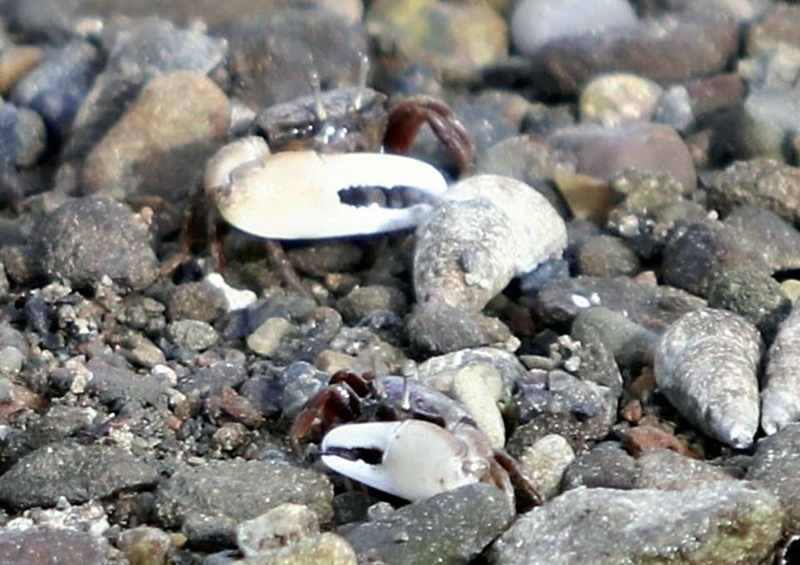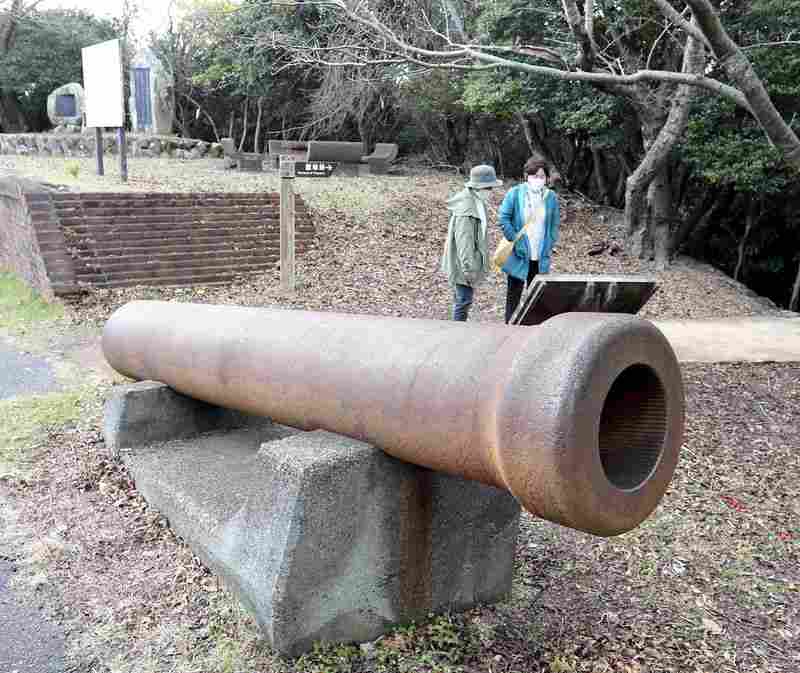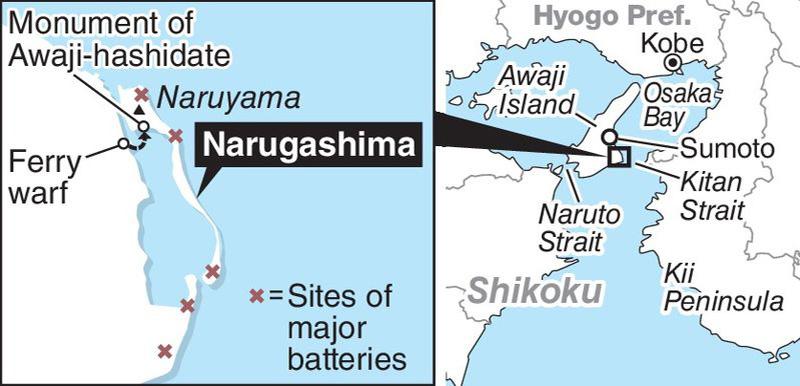
People stand on the Naruyama mountain to see the panoramic view of Awaji-hashidate in Sumoto, Hyogo Prefecture.
16:10 JST, January 22, 2022
SUMOTO, Hyogo — Almost no one knows of the magnificent view on Awaji Island that is comparable to Amanohashidate, a famous tourist destination in Kyoto Prefecture called one of the three most beautiful sights in Japan.
The sandbank stretches about 3 kilometers north to south, as if it were a bridge over the sea, and the breathtaking view is no less glorious than that offered at Amanohashidate.
Despite this, the sandbank is not well-known even on the island. It is indeed difficult to get to the view, but it turns out there were other reasons for its obscurity.
Winding along the surface
I boarded a boat operated by the municipality from a pier in the southeast of Sumoto, a major city on the island. In just two minutes, I reached my destination, a scenic sandbank on the Narugashima islet.

Koichi Hanano speaks while pointing at Narugashima in the back of Sumoto, Hyogo Prefecture.
It’s an uninhabited islet people nearby sometimes call “the other side.”
To see the sandbank from higher up, I climbed a 50-meter-high mountain at the northern end of Narugashima. I enjoyed a panoramic view of the sandbank, which looks as if it winds along the sea’s surface, from an observation spot near the mountain’s peak.
The beauty was naturally created thanks to the sand along the shore. The sandbank is called “Awaji-hashidate,” a reference to Amanohashidate, and comparable to it in terms of size. While Amanohashidate is known to look like a “rising dragon” when seen upside down between one’s legs, Awaji-hashidate looks like a more graceful dragon with a width of only 15 meters at its narrowest point — less than half that at Amanohashidate.
Prohibited
Amanohashidate has been known throughout Japan since ancient times. For example, Sesshu, a renowned medieval ink painter monk, depicted it around the year 1500 in a work that is now designated as a national treasure. However, it was forbidden for even elementary school children to sketch Awaji-hashidate before World War II, the locals said.

A small crab at tidal mudflats
“This was a secret area that was an important military site,” said Koichi Hanano. The 77-year-old leads a group made up of local residents working to beautify Narugashima.
The area has long been important for national defense and sea navigation because of its location at the narrowest point in the Kitan Strait, which separates Awaji Island from the Kii Peninsula, now Wakayama Prefecture.
In ancient times, the major route from the capital to Shikoku via the Kii Peninsula and Awaji Island was called Nankaido, literally the south sea route, and the area around Narugashima was a key point along the route.
The islet, or Awaji-hashidate, was once connected to Awaji Island and was open in the center. Yura Port, a harbor inside the islet, is said to have served as a gateway to Awaji Island. It played the role of a platform for ships coming and going through the mouth.
A castle was built on the mountain in 1613. Naruyama Castle once served as the center for ruling Awaji Island. Both the south and north edges of the islet linking Awaji Island were dug from the late 18th to early 19th century for large ships to enter the port. The mouth at the center of the islet eventually disappeared because of accumulated sand, creating the current landform called a barrier beach, or an offshore bar.

The barrel of a battery that remains at a park in the south of Awaji-hashidate
The importance of such a transportation hub grew in a military sense after 1853, when a U.S. fleet led by Commodore Matthew Perry came to Japan, the locals said.
Under the orders of the Tokugawa Shogunate, batteries were erected on Narugashima to defend Osaka Bay. After the fall of the shogunate, the new Japanese government also built batteries on Naruyama. Command headquarters called the Yura Fortress were placed on the side of Awaji Island, and those who worked there exercised control of the entire fortress from the Kitan Strait to the Naruto Strait.
Never mind taking photos, even drawing the landscape there came to be banned to protect top military secrets.
Treasures left behind
After World War II, the military facilities were destroyed by the General Headquarters of the Allied Powers (GHQ). More visitors came to Narugashima thereafter.
Hisashi Tsuji, an influential Western-style painter, painted the islet and used the word “Awaji-hashidate” for its title. This led to the erection of a stone monument “Awaji-hashidate” there in 1961.

The next year, in 1962, a municipal lodge was opened and began to receive bathers and campers. However, the area lost its liveliness as people’s ideas of leisure changed. The lodge was in business for a quarter of a century before it was closed, and now Narugashima is an uninhabited islet. The regular ferry boat was temporarily suspended though it is now back.
“That may have proved for the best,” said Hanano.
About 300 species of plants, including rare flora, and more than 500 species of marine creatures live on the islet.
I saw small crabs, each about 2 to 3 centimeters in size, moving around tidal mudflats facing the inland sea. The crab, Uca lactea, which has one claw that is much larger than the other, is listed as a vulnerable species. Sea turtles sometimes lay eggs on the sandy beach and on the other side of the sandbank facing the open sea, I heard.
Hanano called Narugashima “a museum with no fences.” Its historical depth and natural richness have now become an indispensable treasure.
Related Tags
"Features" POPULAR ARTICLE
-

Sanrio to Open Museum in Yamanashi Pref. Dedicated to Founder, Exhibits Include Hello Kitty, Other Characters
-

Autumn Foliage Surrounds Visitors to Tokyo’s Showa Kinen Park
-

My Daughter No Longer Speaks to Me, But I Want to See Her and My Grandchild
-

Kumamoto: Public Bath Refurbished as Library Where You Can Chat, Take Photos
-

Frozen Vegetables: Demand Rises for Convenient, Tasty Domestic Produce
JN ACCESS RANKING
-

Tokyo Economic Security Forum to Hold Inaugural Meeting Amid Tense Global Environment
-

Keidanren Chairman Yoshinobu Tsutsui Visits Kashiwazaki-Kariwa Nuclear Power Plant; Inspects New Emergency Safety System
-

Imports of Rare Earths from China Facing Delays, May Be Caused by Deterioration of Japan-China Relations
-

University of Tokyo Professor Discusses Japanese Economic Security in Interview Ahead of Forum
-

Japan Pulls out of Vietnam Nuclear Project, Complicating Hanoi’s Power Plans

























